Difference between revisions of "X5500"
(→FAQ) |
|||
| (22 intermediate revisions by 2 users not shown) | |||
| Line 1: | Line 1: | ||
| + | [[File:X5500-IMG-7948.jpg|thumb|right|X5500 dac board - front]] | ||
| + | [[File:X5500-IMG-7954.jpg|thumb|right|X5500 dac board - back]] | ||
| + | [[File:X5500-IMG-7964.jpg|thumb|right|X5500 dac board]] | ||
| + | [[File:X5500-IMG-7983.jpg|thumb|right|X5500 + X857 + Pi 4 ]] | ||
| + | [[File:X5500-x710.jpg|thumb|right|X5500 + X710 + Pi 4 ]] | ||
{{GD Template Impl}} | {{GD Template Impl}} | ||
==Features== | ==Features== | ||
| Line 15: | Line 20: | ||
| KEY FEATURES || | | KEY FEATURES || | ||
* Full-HD audio – up to 24-bit/192kHz playback | * Full-HD audio – up to 24-bit/192kHz playback | ||
| − | * Audiophile ESS Technology Sabre premier stereo DAC ES9023 | + | * Audiophile ESS Technology Sabre premier stereo DAC <span style="color:red;">ES9023</span> |
* ES9023 delivers jitter-free studio quality audio with 112dB DNR | * ES9023 delivers jitter-free studio quality audio with 112dB DNR | ||
* Built in High quality Class-D stereo audio amplifiers (TI TPA3118D2) | * Built in High quality Class-D stereo audio amplifiers (TI TPA3118D2) | ||
| Line 22: | Line 27: | ||
* Uses the Texas Instruments ultra-low-noise voltage regulator (output noise< 10μVRMS) | * Uses the Texas Instruments ultra-low-noise voltage regulator (output noise< 10μVRMS) | ||
* Uses the Texas Instruments high efficiency step-Down DC converter (up to 95%) | * Uses the Texas Instruments high efficiency step-Down DC converter (up to 95%) | ||
| − | * 6V~26Vdc converted to 5.1V, 3A to power the Raspberry Pi | + | * <span style="color:red;">6V~26Vdc</span> converted to 5.1V, 3A to power the Raspberry Pi |
* Uses the genuine ALPS RK163 series potentiometer for smooth volume adjustment | * Uses the genuine ALPS RK163 series potentiometer for smooth volume adjustment | ||
| − | |||
| − | |||
* High quality digital amplifier inductors | * High quality digital amplifier inductors | ||
* Onboard pluggable speaker screw terminals | * Onboard pluggable speaker screw terminals | ||
| Line 31: | Line 34: | ||
* Optimal design realizes middle -high quality sound and low distortion | * Optimal design realizes middle -high quality sound and low distortion | ||
* Uses the digital I2S audio signals to reduce CPU load over USB audio solutions | * Uses the digital I2S audio signals to reduce CPU load over USB audio solutions | ||
| − | |||
* Powers the Raspberry Pi - no additional power supply | * Powers the Raspberry Pi - no additional power supply | ||
* Reserved Raspberry Pi GPIO 40-pin header | * Reserved Raspberry Pi GPIO 40-pin header | ||
| Line 37: | Line 39: | ||
* AMP can be enabled / disabled with jumper link | * AMP can be enabled / disabled with jumper link | ||
* Compatible with [[X710]] for intelligent power mgmt and cooling your amplifier <ref>Additional M2.5*21 M/F spacers & 2-pin XH2.54 cable required (not supplied)</ref> | * Compatible with [[X710]] for intelligent power mgmt and cooling your amplifier <ref>Additional M2.5*21 M/F spacers & 2-pin XH2.54 cable required (not supplied)</ref> | ||
| − | * Compatible with [[X857]]/[[X856]]/[[X855]] for mSATA SSD storage | + | * Compatible with [[X857]]/[[X856]]/[[X855]] for mSATA SSD storage board, compatible with [[X872]] for M.2 NVME SSD board, compatible with [[X862]] for M.2 SATA SSD board <ref>Additional M2.5*8 M/F spacers required (not supplied)</ref> |
| − | |||
| − | |||
|- | |- | ||
| SPECIFICATION || | | SPECIFICATION || | ||
| − | * Power supply: 6-26Vdc,≥3A recommended | + | * <span style="color:red;">Power supply: 6-26Vdc,≥3A recommended [[X830 V2.0#Power Supply(Optional)]]</span> |
| − | * GPIO used : LRCK - IO19, BCK - IO18, DATA - IO21, IR - IO26, AMP mute - IO22 | + | * <span style="color:blue;">GPIO used : LRCK - IO19, BCK - IO18, DATA - IO21, IR - IO26, AMP mute - IO22</span> |
* RCA Analog audio output level : 2V RMS | * RCA Analog audio output level : 2V RMS | ||
* Amplifier max output power: 2×30W at 4Ω BTL Load at 24Vdc | * Amplifier max output power: 2×30W at 4Ω BTL Load at 24Vdc | ||
| Line 53: | Line 53: | ||
Don't power your Raspberry Pi via the Pi's 40-pin header and Type-C or Micro USB socket at the same time | Don't power your Raspberry Pi via the Pi's 40-pin header and Type-C or Micro USB socket at the same time | ||
|} | |} | ||
| − | |||
| − | |||
| − | == | + | ==Packing List== |
| − | * | + | * X5500 Expansion Board x 1 |
| − | * | + | * Screw M2.5 *6mm x 8 |
| − | * | + | * Spacer F/F M2.5 *20mm x 4 |
| − | * | + | |
| − | * | + | ==User manual== |
| − | + | * [[X450/X5500_Software_Configuration |X450/X5500 Software]] | |
| + | * [[X5500 Hardware]] | ||
| + | |||
| + | ==FAQ== | ||
| + | Q1: What kind of power supply does X5500 use? | ||
| + | |||
| + | A: X5500 use DC 6V~26V widht voltage input, 55x25 jack, please refer to [[X830 V2.0#Power Supply(Optional)]] | ||
| + | |||
| + | |||
| + | Q2: <span style="color:red;">How to solve the heat dissipation problem?</span> | ||
| + | |||
| + | A: Please refer to here: [[P165|embedded armor aluminum alloy heatsink]] can solve your problem. | ||
| + | |||
| + | |||
| + | Q3: Does x5500 support safe shutdown? | ||
| + | |||
| + | A: YES, You can use [[X710]] to achieve safe shutdown function. | ||
| + | |||
| + | |||
| + | Q4: Does X5500 support hdd/sdd storage function? | ||
| + | |||
| + | A: Yes, you can use [[X825]]/[[X857]]/[[X862]]/[[X872]]/[[X829]] etc. to get storage function. | ||
| + | |||
| + | |||
| + | Q5: Is there a matching case to support X5500? | ||
| − | + | A: No yes, we look forward to your feedback, we will consider making a shell according to the needs of users. | |
| − | |||
| − | |||
| − | |||
| − | |||
| − | |||
| − | |||
| − | |||
| − | |||
| − | |||
| − | |||
| − | |||
| − | |||
| − | |||
| − | |||
| − | |||
| − | |||
| − | |||
| − | |||
| − | |||
| − | |||
| − | |||
| − | |||
| − | + | Q6:Does the X5500 support to use with X735? | |
| − | |||
| − | + | A:The X5500 only support to use with the X735 V2.5 VERSION, NOT support other version. And you need need extra one piece 2pin power cable. | |
| − | |||
| − | |||
| − | |||
| − | |||
| − | |||
| − | |||
| − | |||
| − | + | The connection is as follow: | |
| − | * X5500 | + | * X5500 - 5V OUT -> X735 – 5V IN |
| − | * | + | * X5500 – 5V PWR -> X735 – 5V OUT |
| − | |||
| − | + | PWR-Open, the power supply should be connected to X5500 ONLY. | |
| − | |||
| − | |||
<!--增加评论功能! --> | <!--增加评论功能! --> | ||
Latest revision as of 16:52, 15 June 2021
Contents
Features
| FOR USE WITH | Raspberry Pi 1 Model B+/ 2 Model B / 3 Model B / 3 Model B+ / 4 Model B |
| OS |
|
| KEY FEATURES |
|
| SPECIFICATION |
|
| NOTES |
Don't power your Raspberry Pi via the Pi's 40-pin header and Type-C or Micro USB socket at the same time |
Packing List
- X5500 Expansion Board x 1
- Screw M2.5 *6mm x 8
- Spacer F/F M2.5 *20mm x 4
User manual
FAQ
Q1: What kind of power supply does X5500 use?
A: X5500 use DC 6V~26V widht voltage input, 55x25 jack, please refer to X830 V2.0#Power Supply(Optional)
Q2: How to solve the heat dissipation problem?
A: Please refer to here: embedded armor aluminum alloy heatsink can solve your problem.
Q3: Does x5500 support safe shutdown?
A: YES, You can use X710 to achieve safe shutdown function.
Q4: Does X5500 support hdd/sdd storage function?
A: Yes, you can use X825/X857/X862/X872/X829 etc. to get storage function.
Q5: Is there a matching case to support X5500?
A: No yes, we look forward to your feedback, we will consider making a shell according to the needs of users.
Q6:Does the X5500 support to use with X735?
A:The X5500 only support to use with the X735 V2.5 VERSION, NOT support other version. And you need need extra one piece 2pin power cable.
The connection is as follow:
- X5500 - 5V OUT -> X735 – 5V IN
- X5500 – 5V PWR -> X735 – 5V OUT
PWR-Open, the power supply should be connected to X5500 ONLY.
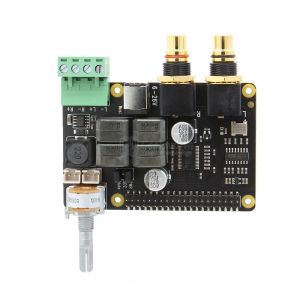
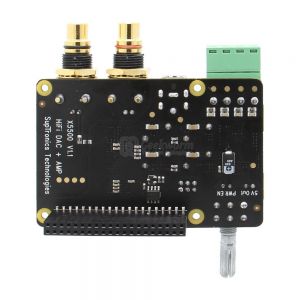
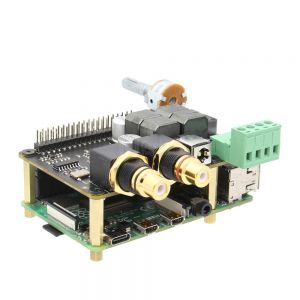
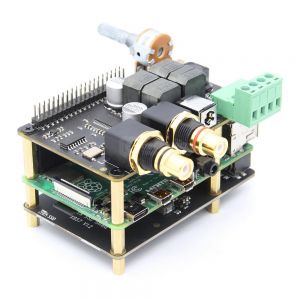
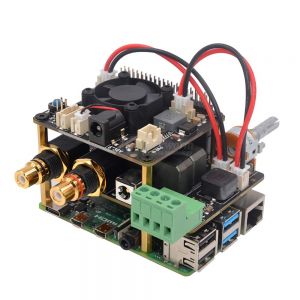
Enable comment auto-refresher